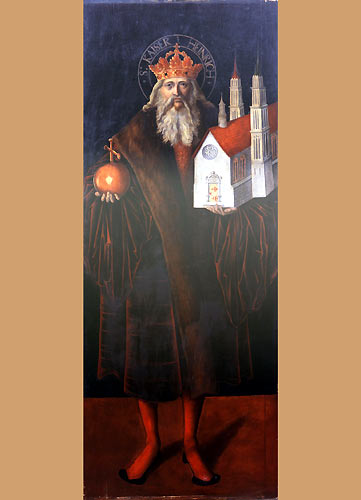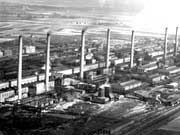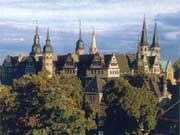"Mersiburc civitas" - 1st reference in the 9th centuryFor the first time Merseburg was mentioned as "Mersiburc civitas" in the Hersfelder tenth list about 850/860. Already in the Stone Age the hill with his precipitous shore served for the hall as a connection and protective castle. The castle lay in the early Middle Ages on the border to the Slav's area and served as a protection against raids. So also for the Carolingians. They presumably protected themselves not only from the Slavs but also from the Saxons.



|
Year |
Events |
|
830/850 |
When "Mersiburc civitas" mentions for the first time in the Hersfelder tenth list in a document |
|
after 919 |
Extension of Merseburg to the Palatinate by king Heinrich I. |
|
933 |
Won battle with Riade, the army Heinrichs I against the Hungarians |
|
955 |
Emperor Otto I promises to donate a diocese before the battle on the field Lech near Augsburg, in case of a victory over the Hungarians sunken once more in Germany, in Merseburg |
|
968 |
Merseburg becomes a bishop's seat |
|
981 |
Abolition of the diocese Merseburg by pope Benedict VII. |
|
1004 |
Emperor Heinrich II founds the diocese anew |
| 1015 |
Laying of the foundation stone to a new building of the cathedral by bishop Thietmar |
|
1021 |
Cathedral inauguration in the presence emperor Heinrichs II who prefers Merseburg to all other Palatinate places |
| 1180 | Rudolph von Schwaben dies and is buried in the cathedral 1135 court days with big international participation 1152 emperors Friedrich I (Barbarossa) holds his first court day in Merseburg |
| 1188 | Barbarossa records the new market in Merseburg, first mention of the new market church Saint Thomae and the new market bridge |
| 1212 | Renewal of a royal possession after which Merseburg remains one of the Pfalzen in which mainly the relations to the eastern and northern neighbours of Germany are regulated |
| 1218 | Bishop Ekkehard allows to pull a wall ring around the settlement cores as well as the external cathedral freedom 1252 last mentioned stays of a German king or emperor of the Middle Ages in Merseburg about 1280 first mentions of the crooked gate as well as a cathedral organ |
| 1289 | The first middle-class self-government in Merseburg and on the document seal appears the city coat of arms |
| 1323 | First of six heavy city fires which contribute and a. to the fact that fair trade shifts to Leipzig |
| 1362 | Outbreak of a long stopping quarrel between city and bishop |
| 1387 | More once more big, fateful fire |
| 1426 | The city joins to the Hanse |
| 1444 | Thyme fire; all documents and privileges of the city are destroyed, on this occasion, around |
| 1470 | Castle new building by bishop Thilo von Trotha in the Late-Gothic style |
| 1473 | the oldest printers of northern Germany are pursued in Merseburg |
| 1483 | Bishop Thilo von Trotha allows to increase the Gotthard pond |
| 1504 | Breach in a dam of the Gotthard pond |
| 1525 | In the course of the Peasants' War citizens and farmers of surrounding villages try to storm the cathedral freedom |
| 1543 | In Merseburg the Reformation begins |
| 1545 | New city privilege; Martin Luther preaches in the Merseburger cathedral |
| 1575 | Foundation of the cathedral high school |
| 1631 | In the battle with width field becomes Tillys army of the army of the Swede's king Gustav II allied with health resort Saxons. Adolf hit |
| 1632 | Battle near to Lützen, one of the main battles of the Thirty Years' War (in 1618-1648), in course the Swede's king Gustav II. Adolf falls |
| 1656 | Merseburg becomes a residence for the dukes of Sachsen-Merseburg |
| 1662 | Altenburg will surround with a wall (white wall); again heavy city fire |
| 1707 | Karl XII, king of Sweden, stays after the conclusion of peace of Altranstädt in Merseburg |
| 1757 | Battle in Rossbach, during the seven-year-old war (in 1756-1763) between the Prussian king Friedrich the tallness and the French |
| 1806 | Napoleon stays in the castle |
| 1813 | After the national battle fleeing French and they pull pursuing allies by Merseburg |
| 1816 | Merseburg becomes a district government seat in the Prussian province Saxony |
| 1831 | union of 4 parts of town (city, cathedral freedom, Altenburg and new market) |
| 1841 | Discovery of the Merseburger charms in the cathedral pencil library by Dr. Waitz |
| 1848 | For the first time becomes in Merseburg the Black-Red-Gold-Flag ; political associations are founded and there occur the first election |
| 1906 | Industrial development of the brown coal fields in the nearby hostage's valley |
| 1916 | The ammonia factory Merseburg (later Leuna factory) was built |
| 1933 | Swastika flags on public buildings after Hitler's election victory; 1000-annual celebration of Merseburg |
| 1935 | Construction of the air base Merseburg |
| 1936 | Laying of the foundation stone for the Buna factory |
| 1944 | The heaviest attack of the 2-nd world war on Merseburg directs disastrous damagesan |
| 1953 | Strikes, Merseburger worker take the of a circle service place of the ministry of state security |
| 1954 | Technical college "Carl Schorlemmer" Leuna-Merseburg takes up the teaching company; Merseburg becomes a university city and science location |
| 1968 | Big parts of the Old Town fall victim to the " socialist reconstruction " |
| 1990 | For the first time since 1945 again free local elections; a new renovation draught for the Merseburger Old Town is decided |
| 1992 | Participation of the city in the Hans's floors of the modern times; advanced technical college of Merseburg is founded; there originates the administrative collectivity Merseburg (member's municipalities are Merseburg, Beuna and Geusa) |
| 1997 | The Lenin monument which was on the Gotthard pond is transported to Holland |
| 1998 | The land Saxony-Anhalt hands over the Merseburger state house of the city, therefore his comprehensive renovation begins |
| 2004 | New inauguration of the Ladegast organ in the Merseburger cathedral to 34. Merseburger to organ days |